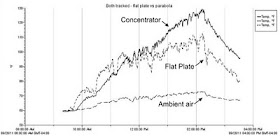Flat plate thermal collectors are not normally rotated to face normal to the sun but it is commonly accepted that if tracking can be used, it will increase the effectiveness of the solar heating or PV. Since the mechanism was available (and necessary) for the concentrator, I decided to try rotating the flat plate collector.
In this view of the rear, the linkage that controls the position of the collectors can be seen. At the far end is the linear to angular motor drive that moves the assembly. The small pin with two screws parked temporarily on the beam is the stop that I used to lock the flat plate collector in a fixed position in the previous test.
At the beginning of this test I saw that the concentrator was partially shading the flat plate collector (see the first picture above). In spite of this partial shading, the flat plate started heating quickly.
As can be seen in the first picture above (best if you click it to see an enlarged view), the surface of the mirror was covered with water drops from the rain we had last night. This would tend to scatter the sun's light at the beginning of the test. I did not clean the mirror.
I also noticed at the beginning that the concentrator was not tracking true and the image of the sun was offset somewhat on the collector tube. This means lost heat as the sun's light does not completely fall on the collector. I noticed that the sensor housing had fogged somewhat and this may have contributed to the poor focus. I continued with the test. We don't get many great clear days anymore and winter is coming. I have more tests to do.
As is normal at this time of year here, the day was mostly sunny with clouds. There was almost no wind. By mid-afternoon however, the cloud cover was solid and at the end of the test, it had started to rain.
Here is the day's results with BOTH collectors tracked. As with the previous test, both collectors are UN-insulated. Tests of insulated collectors will be done next.
You will see that I added a channel for the ambient air temperature. That sensor is out of the sun under the deck, about four feet off the ground, not touching anything but air.
As noted, the flat plate starts to warm rapidly in spite of the partial shading which only lasted about 20 minutes into the test. As clouds pass overhead, the rapid cooling of the uninsulated flat plate noted in the previous test occurs here also. This is thought to be due to the large metallic surface area of the absorber plates. The concentrator is also uninsulated but it has much less metallic surface area so it does not cool as quickly.
By about noon, the concentrator reservoir temperature exceeds that of the flat plate and it remains higher for the duration of the test. The maximum is reached just before the sky completely clouds over at about 14:13 when the differential between the two reaches 17.45 F degrees (ambient is 72.4F). Even at the end of the test when light rain is occurring, the concentrator reservoir is still 16.9 F degrees higher than the flat plate with an ambient air temp of 66.9F.
I will be busy for a few days switching over to the insulated configurations for both the flat plate and the concentrator but I hope to have results from the next set of tests sometime next week.
Perhaps I should change the working fluid to 50/50 water/glycol in anticipation of winter? Brrr.
Index - Comparing concentrator to flat plate solar collector









































